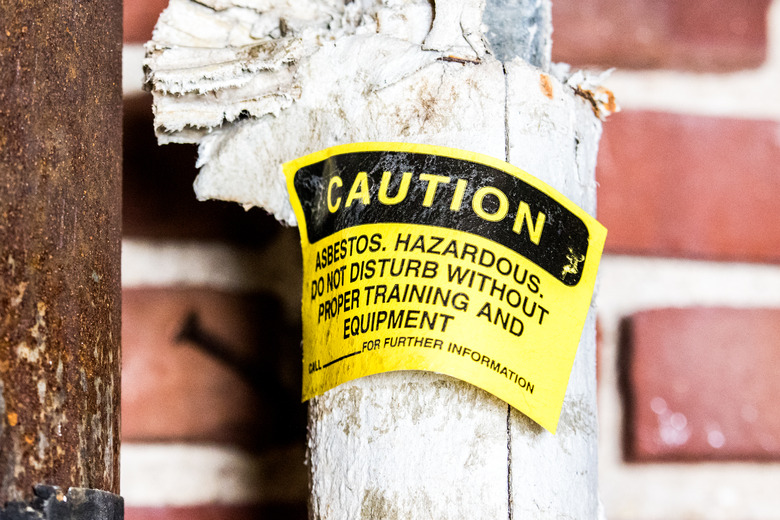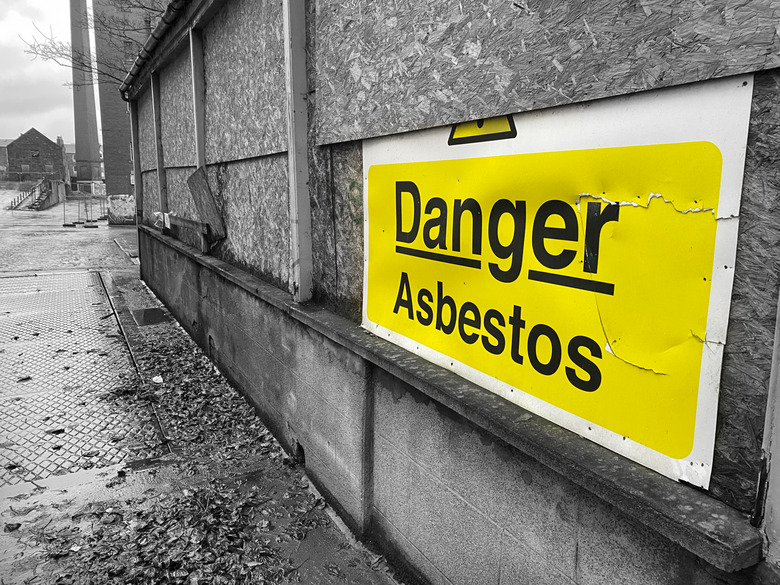Here's Why Asbestos Fibers Are So Dangerous
For as much as you've heard about asbestos (likely those late-night commercials about suing over asbestos exposure), you might not have heard that asbestos fibers are actually useful — they were often used in products like fireproof clothing, insulation and other building materials. Archeologists have even discovered asbestos mineral fibers in debris dating back to the Stone Age, some 750,000 years ago. Of course, however, they are also deadly, which wasn't discovered until the turn of the 20th century when scientists started to connected it to disease. But why exactly are they so dangerous?
Asbestos exposure can cause a number of different types of cancer, including mesothelioma and lung cancer, and inhalation is also responsible for other conditions, including asbestosis, pleuritis and COPD, which are all types of lung disease. Asbestos-related disease is most common among workers who have actively mined asbestos and processed asbestos products, but their family members as well as people living in environments in which asbestos fibers are present are also vulnerable. That includes people living in homes made with building materials that contain asbestos, such as insulation, floor tiles and shingles, as well as construction and shipyard workers who release the fibers in the course of demolition work.
Asbestos is a unique class of minerals that won't burn and also provides thermal and electrical insulation, adds tensile strength to concrete and other rigid building materials and is soft and fibrous enough to weave into cloth. The very usefulness of asbestos is one reason it's so dangerous — because there's often no suitable substitute, people continue to use it (in a limited way) despite the public health risk. The United States Environmental Protection Agency (EPA) tried to ban asbestos altogether, but the ban was overturned by a federal court. Since it isn't going away, it's important to understand what asbestos is and why it's so dangerous.
Different Types of Asbestos Fibers
Different Types of Asbestos Fibers
Asbestos is a collective term for two classes of fibrous minerals that occur naturally in the earth's crust and are obtained by mining. The two classes are serpentine asbestos, which has curly fibers, and amphibole asbestos, which has straight, needlelike fibers. Studies show that of the two, amphibole asbestos is the more dangerous carcinogen, but both types are responsible for asbestos-related diseases.
Chrysotile asbestos, or white asbestos, is the only one with curly fibers. It's the most common type, historically accounting for 95 percent of asbestos use. It has been used to make construction materials and adhesives, roofing, pipe and wall insulation and gaskets and linings in the automobile industry. It's the type ancient people wove into cloth, and, in fact, people still use it to make fireproof fabrics.
Amosite, or brown asbestos, has been used in the past to strengthen cement sheets and insulate pipes and buildings. It's the second most common type of asbestos and poses a higher cancer risk than chrysotile asbestos.
Crocidolite, or blue asbestos, was often used to insulate pipes and was a component of certain spray coatings and plastic products as well as adhesives in the shipbuilding and construction industries. It may be responsible for more deaths than any other type of asbestos because of its ultra-thin fibers, which are so delicate that crocidolite was used in the manufacture of cigarette filters. (That's right — cigarette filters!)
Anthophyllite, actinolite and tremolite have typically been used less than other types of asbestos, but they frequently occur as contaminants in talc and vermiculite, which are also naturally occurring minerals. Vermiculite was a popular insulation material, but its use was discontinued in 1990. The use of talc in cosmetics is under investigation by the Food & Drug Administration, which has yet to make a recommendation.
The EPA and the Occupational Safety and Health Administration (OSHA) have the authority to regulate these six types of asbestos, but the U.S. Bureau of Mines and the National Institute for Occupational Safety and Health recognize other fibrous minerals, including winchite, richterite, erionite and taconite, that have asbestoslike properties and are currently unregulated. The Agency for Toxic Substances and Disease Registry, which is part of the Centers for Disease Control and Prevention, warns that these unregulated minerals can have the same adverse health effects as asbestos.
Asbestos Fibers Take Years to Damage Your Body
Asbestos Fibers Take Years to Damage Your Body
Asbestos fibers are tiny — so tiny that they are invisible — and once released, they can remain airborne for days. They have no perceptible odor, so anyone who happens to be in the vicinity unwittingly inhales them. Once in the body, they stay there indefinitely, creating constant irritation in the lining of the lungs, stomach and other organs that results in microscopic scarring and eventual loss of function.
It takes 10 to 40 years for this scarring to develop into full-blown disease, and since the fibers are invisible, the only way to detect them is by observing the scarring they cause using X-rays or a CAT scan. The presence of scarring often indicates that disease has already progressed to a dangerous stage, and while there are treatments for asbestos-related disease, there is no way to remove the asbestos fibers, so there is no cure.
Exposure to asbestos is most likely to result in asbestosis, a condition characterized by shortness of breath, persistent coughing, weight loss, chest tightness and clubbing of the fingers and toes. The inflammation and scarring caused by the fibers in the lungs and abdomen can also promote the growth of cancerous tumors, resulting in lung cancer or a condition known as mesothelioma. The National Cancer Institute points to asbestos exposure as the main cause of this disease of the thin tissue (mesothelium) that lines the lungs, chest wall and abdomen.
From the Friable Pan to the Fire
From the Friable Pan to the Fire
There were slightly more than 80 million houses in the United States in 1978 — the year asbestos was banned in most construction materials — and many of those are still occupied, which means that a large number of people could be exposed to asbestos without knowing it. Asbestos was used in a long list of seemingly innocuous materials, including:
- Air duct seam tape and insulation
- Drywall, plaster and drywall joint compound
- Floor tiles and tile adhesives
- Cement pegboard and bender board
- Wire insulation
- Acoustic ceiling tiles
- Caulking and glazing compounds
The list goes on and includes items such as asbestos insulation in the walls and attic. As long as the materials remain undisturbed, the asbestos is encapsulated and considered safe. The problem is that these asbestos-containing materials (ACMs) deteriorate, especially after a period of 40+ years, and when they do, they become friable, which means they are able to release asbestos fibers into the atmosphere.
Examples of nonfriable ACMs becoming friable include old asbestos ceiling tiles beginning to crumble and flake, asbestos cement cracking, asbestos drywall joint compound chipping off the wall, vinyl floor tiles containing asbestos cracking and breaking and asbestos pipe insulation suffering water damage from a plumbing leak. Homeowners undertaking renovations can also unwittingly create asbestos dust during demolition. Remember that the effects of asbestos inhalation don't show up for at least 10 years, so it's possible to inhale a debilitating amount of asbestos without noticing any immediate ill effects. That fact should make anyone who lives in a house predating 1978 to sit up and take notice.
Who Is at Risk of Asbestos Exposure?
Who Is at Risk of Asbestos Exposure?
Although homeowners may be at risk, the bulk of people who suffer debilitating asbestos-related diseases are those who work or have worked in asbestos mining operations and in factories that produced products containing asbestos. Moreover, of these, only 20 percent develop conditions such as asbestosis, pleuritis and cancer.
Construction workers, plumbers and firefighters are also in a higher risk group, as are family members of workers in asbestos-related fields, including women and children, who can suffer secondary exposure and develop health problems. Because of the heat-resistant properties of asbestos, the EPA still allows its use in brake pads, so health risks continue to be high for auto mechanics and their family members.
The type of asbestos to which a person is exposed matters. Crocidolite (blue asbestos) has the most carcinogenic fibers, and it's the type used in ceiling tiles, insulation and Kent micronite filter cigarettes. Fortunately, micronite filter cigarettes were on the market for only a short time — from 1952 to 1956 — but anyone who smoked them as well as anyone who inhaled secondhand smoke from them was exposed. Those who worked in factories that produced the filters could develop symptoms even today. All smokers have a higher cancer risk than nonsmokers, but people who smoked micronite filter cigarettes are in a class of their own.
Symptoms of Asbestos-Related Disease
Asbestosis is the most common asbestos-related disease, and because it affects the lungs, people suffering from this disease experience shortness of breath, coughing and chest pain. Asbestos can be present in other parts of the body, however, and when this happens, people may experience some of the following symptoms:
- Abdominal or pelvic pain
- Weight loss
- Hernia
- Loss of appetite
- Bowel obstruction
- Difficulty swallowing
Asbestos is a known carcinogen, and any asbestos-related disease can develop into lung, laryngeal or ovarian cancer or mesothelioma. Anyone with a history of exposure to asbestos who develops symptoms of asbestos-related disease should be screened for cancer every three to five years. It usually takes a variety of screening methods, including a chest X-ray, a low-dose CT scan, a bronchoscopy or a pulmonary function test to diagnose mesothelioma. Early detection is key to successful treatment.
Where to Get More Information
Where to Get More Information
There is no shortage of asbestos-related information on the internet, but the most complete resource is Asbestos.com, which is maintained by the Florida-based Mesothelioma Center. It provides a complete history of asbestos use through the ages; a description of the different types; a complete description of causes, risk factors and symptoms of asbestos-related diseases; and a discussion of treatment options.
The site can also point you to doctors and health care centers in your area that deal specifically with asbestos-related diseases, and it also provides a phone number for in-person counseling. If you're concerned about hiring an asbestos abatement contractor, Asbestos.com is also a number-one resource along with the EPA's asbestos site, which outlines the federal requirements for home renovation, demolition and cleanup operations. Many state governments also have online resources that outline training and licensing requirements for asbestos contractors. One such resource is the page maintained by the California Air Resources Board.
For work-related information, visit OSHA's asbestos page, and for consumer-related information, visit the Consumer Product Safety Commission's page. Your local health department is also a valuable resource when it comes to asbestos safety. If you're planning to hire an asbestos abatement contractor, first check with the local building department, where you'll often find valuable information about local regulations concerning disposal of materials that contain asbestos.
References
- Asbestos.com: Types of Asbestos
- Asbestos.com: History of Asbestos
- Agency for Toxic Substances and Disease Registry: Asbestos and Your Health
- Stanford University Environmental Health & Safety: Asbestos Fact Sheet
- Mayo Clinic: Asbestosis
- United States Environmental Protection Agency: Asbestos
- California Air Resources Board: Asbestos Resources
- Occupational Safety and Health Administration: Asbestos
- Consumer Product Safety Commission: Asbestos in the Home
- U.S. Food & Drug Administration: Talc

